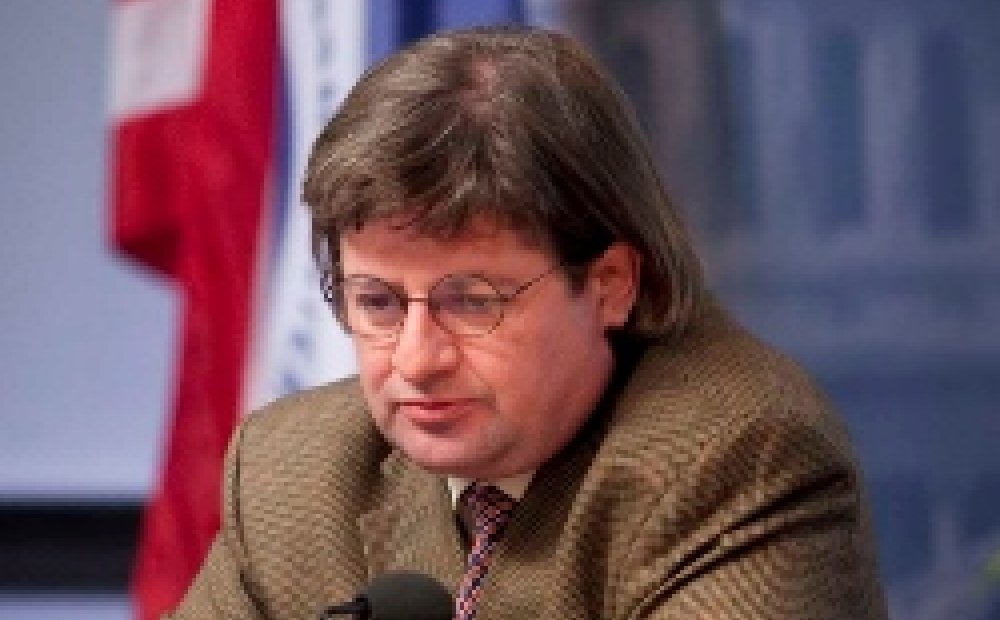Monument Wars across the Post-Soviet Space as a Conflict of Memories and Cultures

“The destruction of monuments is not only a political expression, but also an attack on historical and artistic values,” argued Peter Cheremushkin, journalist and Art Historian, Association of Scholars of Russian Society-XXI Century (АИРО-XXI), at a 23 January 2012 Kennan Institute lecture. The “monument wars” following the collapse of the Soviet Union, which ranged from Russia to the former Soviet and Warsaw Pact states, bring into question notions of self-identity and ideology of a nation.
Cheremushkin noted that the destruction of monuments following a regime change is common place in history. For example, the rise of Bolshevism in 1917 brought the destruction of tsarist symbols and idols, such as the massive monument to Tsar Alexander III in St. Petersburg. This struggle between ideologies can help wiping the social memory of an unwanted past. Furthermore, creating monuments to honor prominent figures or historic events presents new challenges, the speaker asserted. Indeed, public opinion can differ greatly about certain monuments and the figures that they celebrate. For example, a monument in Ukraine erected to Stepan Bandera, who headed a Ukrainian independence group during World War II, attracted tremendous controversy when it was erected. To some, he represented a fighter for Ukrainian independence; to others, he represented a traitor who collaborated with Nazi Germany.
In Poland, monuments to Soviet leaders such as Lenin and Dzerzhinskiy were destroyed immediately after the regime change in 1989, and most commemorations of Soviet Marshals were removed from popular public squares soon thereafter. To replace these monuments, statues of the Pope John Paul II and busts of Ronald Reagan were erected. Nevertheless, one statue of Lenin was re-erected in the town of Poronino in 2011, because the Mayor realized that it was the only way to attract Russian tourism.
There is public dispute in present-day Russia as well, the speaker added, as exemplified by renovated metro stations. In one station (“Elektrozavodskaya”), an image of Stalin once carved in the circular figure on the metro station wall is now blank—yet another recently-renovated metro station features a quote by Stalin in large print (“Kurskaya”). Many political disagreements have evolved with the modern restoration of the old monuments, demonstrating the ongoing struggle over Russia’s new identity and ideology.
Cheremushkin contended that German society—in contrast to the post-Soviet monument wars in Poland, Estonia, and Russia—has taken a different approach to old monuments, in the belief that their preservation is important to understanding the country’s past. In the period following the reunification of Germany, most of the monuments remain untouched in accordance with certain agreements between the German and Russian governments. Particularly in Berlin, in addition to monuments dedicated to Lenin and victorious Red Army soldiers, there remains artwork from the Third Reich at the 1936 Olympic Stadium, as well as busts of Adolf Hitler, which were on display in 2010 at the Historical Museum. These surviving memorials demonstrate that German society reconciled with its historic past much more than the societies in the other post-Soviet countries.
Cheremushkin closed his talk by emphasizing the historical and artistic effects of this battle on society. He compared two renowned sculptors of the twentieth century: Lev Kerbel and Arno Breker, who were respectively commissioned by the Soviet Union and the Nazi Party in the Third Reich to create monuments celebrating various party leaders. Yet a large number of their works—notably, mostly Breker’s artwork—was destroyed over the years because of the pieces’ controversial symbolism in Soviet and German history. However, most of the works by Kerbel remain intact, including huge monuments to Karl Marx in Moscow and Hemnitz, and the last monument to Lenin that was built in the Soviet Union, which still stands on Kaluzhskaya Square in Moscow. Breker and Kerbel stated that they had no regrets for what they accomplished in their artistic careers, as their works were intended to be seen as art; however, monuments are infused with more meaning. The speaker emphasized that, unlike Germany, it is obvious that Russia is still conflicted about its current and past heroes and symbols—regardless of whether those heroes are Lenin, tsars, or Marshal Zhukov. Cheremushkin concluded that the clash and chaos of ideas and attitudes concerning monuments across the post-Soviet region has ultimately led to the collective devaluation of the monument as a commemorative, positive symbol.
By Elena Volkava
Blair Ruble, Director, Kennan Institute
The Kennan Institute speaker series is made possible through the generous support of the Title VIII Program of the U.S. Department of State.
Speaker
Hosted By

Kennan Institute
After more than 50 years as a vital part of the Wilson Center legacy, the Kennan Institute has become an independent think tank. You can find the current website for the Kennan Institute at kennaninstitute.org. Please look for future announcements about partnership activities between the Wilson Center and the Kennan Institute at Wilson Center Press Room. The Kennan Institute is the premier US center for advanced research on Eurasia and the oldest and largest regional program at the Woodrow Wilson International Center for Scholars. The Kennan Institute is committed to improving American understanding of Russia, Ukraine, Central Asia, the South Caucasus, and the surrounding region through research and exchange. Read more
